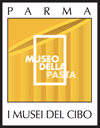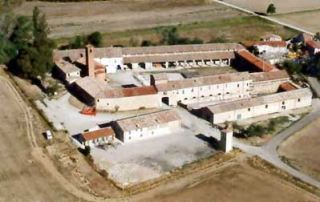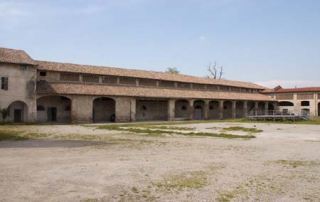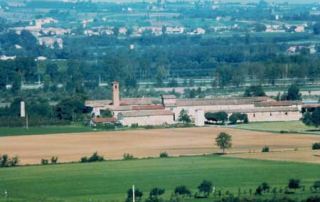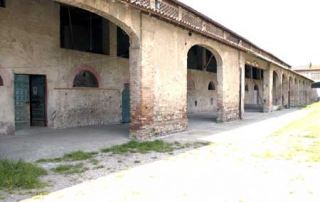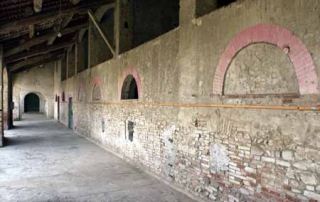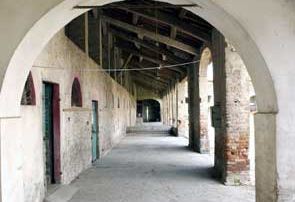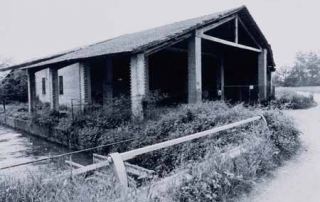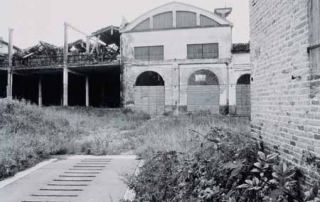In the beautiful medieval farming court of Giarola (Collecchio), located on the right bank of the Taro River and aligned with the Francigena Road that lead pilgrims towards the Eternal City of Rome, The Pasta Museum was set up next to theTomato Museum. Created in the wider context of the Food Museums of the Province of Parma (Parmesan Cheese in Soragna, Wine Museum in Sala Baganza, Salame Museum in Felino, Prosciutto and Cold Cuts Museum in Langhirano), this completes the in depth path to the discovery of the most important Italian food products of the territory.
Of Middle Eastern origins, dried pasta made of Durum wheat found in Italy its elective homeland, and developed through the centuries in different areas of the Country: in Sicily, Liguria, in Naples, and Bologna. In the 1800s in Parma the activities of Barilla, which is today a world leader in the sector, began. The company contributed in a determining manner to the creation of the museum dedicated to pasta featuring ten sections on historical sources, the technology and culture of pasta.
Brief history of the Court of Giarola, an ancient center for agribusiness processing
Giarola rises on the right bank of the Taro River at about halfway between Fornovo and Pontetaro. The meaning and origin of the toponym are easy to decipher: Giarola was the name for small gravel of the Taro River in Roman or High Middle Ages era. The stronghold of one of many fords of the river, Giarola was on the road at the foot of the hills that coming from the Baganza Valley and Talignano lead to Medesano, Noceto and Borgo San Donnino. The location, entirely on flatland, was enclosed between Oppiano in the south, the main road on the east, the Scodogna torrent in the north, and the Taro River in the west through historic times, from the mid XI Century. The first historical sources are from this period and tell us that the place became the property of the Nunnery of Saint Paul. The home of a small monastic community, a church, stables and cowsheds, dwellings, a mill and a dairy farm were built around it: a rural court, therefore, that was self-sufficient and protected with solid walls, so that in some documents it is also called “castrum” (fortress) and castle. The water of the Naviglio Taro canal that like today, back then had its origin uphill, starting in Ozzano, moved the mill. Later on, it started to flow slightly more towards the valley, near the church of Oppiano, where there was a monastic court as well. This belonged to the Benedictines of Saint John the Evangelist and had a mill and perhaps also a “xenodochio”, that is a small hospice to host the pilgrim that traveled along the river going towards Fornovo to face the mountainous path of the Francigena Road, also called Romea Road.
The canal of Naviglio Taro flowed through Collecchiello and Vicofertile and brought water to Parma through the Door of Saint Francis, today called Barriera Bixio, and reached as far as the fishing basin of the Ducal Park. The water moved various mills and factories in the country and in town, up to the Ducal Factory of glass and majolica that was bought by the Bormioli family in the mid-1800s.
All of this fluvial area, at one time surely swampy and covered with thick woods, at the onset of the first millennium was therefore already reclaimed and turned into a productive land. The cultivations were wheat, forage, vines and rice. The rice paddy that existed already in the 1500s was eliminated following a ducal decree, but later on in the 1800s was established again since it was very profitable; rice paddies were declared dangerous for public health and were definitively suppressed in 1874.
The Castle had its strategic importance, though limited, since at the beginning of the XIV century was bitterly fought over during the fight between the factions that gathered around the most important families of Parma. In 1451, it hosted the Duke Francesco Sforza who arrived from the Piacenza area travelling through Parma. Part of the army of Colleggiati lead by Francesco II Gonzaga camped there, who dated some of his letters from Giarola on the eve of the Battle of the Taro River on July 6, 1495.
Giarola was part of the system of castle fortifications of the territory. Just to mention the immediate surroundings, other castles or fortified courts were located in Madregolo, Collecchio, Segalara, Carona and, beyond the Taro, in Noceto. Almost all of these were possessions of the Rossi family [1]. The church instead, originally a simple chapel, though located on the pilgrimage path of the Francigena Road, did not have then distinctive title of “Pieve” (church), and as early as 1230 was subordinate to the nearby church of Collecchio. For sure, though, it had the characteristics of a “plebana” (medieval church) with a Gothic façade, a semicircular apse and small arches in baked ceramic, some of which survived the various large restoration works through time and particularly in the XVIII century, and survived World War II bombing as well. Inside, among other things, there is an Annunciation painting of a skillful follower of Malosso, perhaps Francesco Lucchi (as suggested by Giuseppe Cirillo and Giovanni Godi) of the beginning of the 1600s, placed in a frame from the 1700s. Inside the church as well, there are a Sacred Family with Saint Joachim and Anna painting, of good quality, of the second half of the 1700s and a front altar cover in painted and worked leather of the same period [2].
1 Lino Lionello Ghirardini, La Battaglia di Fornovo: un dilemma della Storia, 2ª ed., Edizioni Storiche d’Italia, Parma, Tip. Bassoli, 1981, pp. 27, 164.
2 Italo Dall’Aglio, La Diocesi di Parma, vol. I, Parma, Scuola Tipografica Benedettina, 1966, pp. 532-534.


